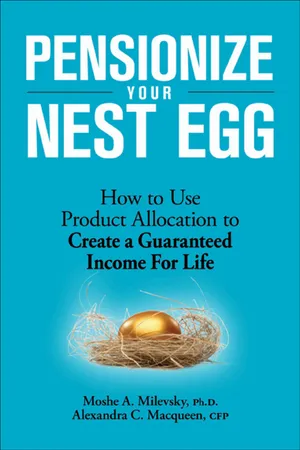
Pensionize Your Nest Egg
How to Use Product Allocation to Create a Guaranteed Income for Life
- English
- ePUB (mobile friendly)
- Available on iOS & Android
Pensionize Your Nest Egg
How to Use Product Allocation to Create a Guaranteed Income for Life
About This Book
Pensionize Verb. 1. To convert money into income you can't outlive. 2. To create your own personal pension, a monthly income that lasts for the rest of your natural life.
With the subpar performance of the markets, record-high personal debt levels, and shockingly low savings rates, it's clear that many Canadians expecting to retire in the next decade simply don't have a sufficient nest egg to ensure a worry-free retirement. Making matters worse, only about one-third of Canadians currently belong to a formal, or registered, pension plan; and even a large number of that "lucky third" will not retire with a guaranteed pension income.
If you no longer have the time to wait and hope for your traditional investments to pay off, the answer is to "pensionize your nest egg" using the new technique of product allocation set out in this book. Pensionize Your Nest Egg explains how to
- Recognize if you really have a pension or just a tax-sheltered savings plan.
- Become informed about the new risks you and your nest egg face in retirement and why asset allocation, despite its value in the accumulation stage of life, is not sufficient to protect you and your money.
- Measure your retirement sustainability quotient (RSQ) and your Financial Legacy Value (FLV)-then choose a retirement income plan on the Retirement Income Frontier.
- Understand how product allocation differs from asset allocation, how to allocate your nest egg across three product silos, and learn about the new financial products that are available to protect against the new risks you face.
- Follow a seven-step process to close your Pension Income Gap and convert your retirement savings into a secure stream of lifetime income.
Whether you do it yourself or work with a financial advisor, Pensionize Your Nest Egg gives you a simple plan to create a guaranteed retirement income-for life.
Frequently asked questions
Information
Table of contents
- Title Page
- Copyright Page
- Preface
- Introduction
- PART ONE - Why You Need to Build Your Own Pension Plan: The Most Predictable ...
- PART TWO - Developing A Sustainable Retirement Solution: The Modern Approach ...
- PART THREE - The Seven Steps to Pensionize Your Nest Egg
- Final Thoughts
- Notes
- Bibliography
- Acknowledgements
- About the Authors
- Index